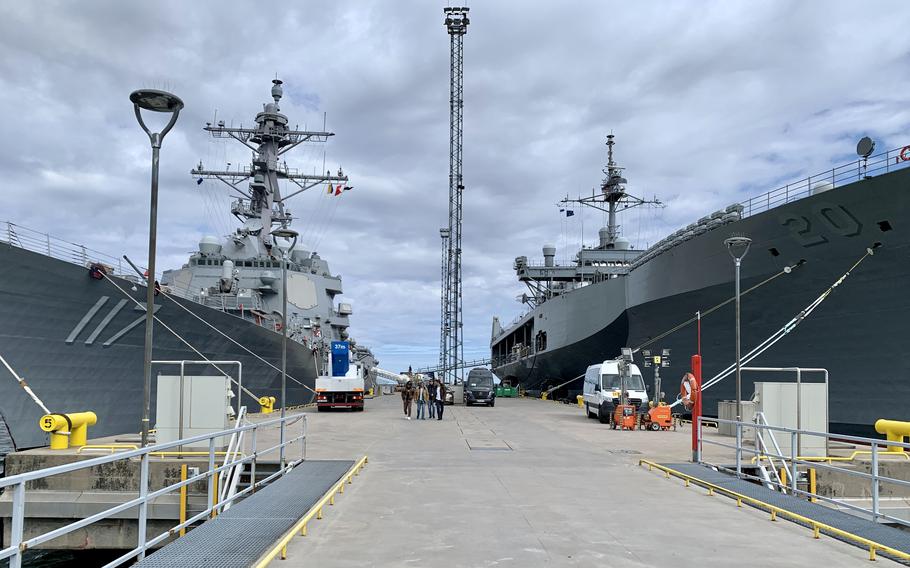
The destroyer USS Paul Ignatius, left, and the amphibious command ship USS Mount Whitney are moored side by side in Tallinn, Estonia, on Saturday, June 2, 2023. The ships are among 50 vessels from 20 countries taking part in BALTOPS, an annual maritime exercise in the Baltic Sea. (Alison Bath/Stars and Stripes)
TALLINN, Estonia — NATO is ready if conflict with Russia arises, but finding ways to enhance overall readiness is critical and more work is needed, a U.S. admiral said this weekend just before an annual Baltic Sea exercise kicked off.
Lessons from the war in Ukraine have NATO better-prepared than it was a year-and-a-half ago, Vice Adm. Thomas Ishee, commander of U.S. 6th Fleet and Striking and Support Forces NATO, said Saturday, the day before the start of BALTOPS.
NATO is reshaping its force readiness plans to better adapt to threats. Those plans are not yet finalized, but as more is learned about them, exercises are being adapted to ensure that “we are rehearsing the right things,” Ishee said.
Although the Russian bear always looms large in the Baltics, Ishee and other commanders stressed that BALTOPS is not about Russia.
Rather, the exercise is intended to improve the alliance’s proficiency and build the trust needed to deter any enemy, they said.
And with the accession of Finland in April and the likely addition of Sweden pending, the alliance will boast a decisive edge in the Baltic Sea region, said Spanish Lt. Gen. Luis Lanchares, deputy commander of Allied Joint Force Command Brunssum in the Netherlands.
“As soon as Sweden becomes part of NATO, nearly the entire Baltic coast will be NATO nations,” Lanchares said.
The 52nd iteration of BALTOPS began Sunday with roughly 20 participating countries, including Britain, France, Germany, Italy, Latvia and Turkey, the Navy said.
The two-week exercise includes 50 ships, more than 45 aircraft and 6,000 personnel, said Cmdr. Richlyn Ivey, a spokeswoman for U.S. Naval Forces Europe-Africa/U.S. 6th Fleet. It ends June 16.
NATO has bolstered its presence in northeastern Europe in recent years. It has established battalions in Estonia, Latvia, Lithuania and Poland and sent more ships and resources to the Baltic Sea, according to the alliance.
Those and other actions, particularly since full-scale war broke out in Ukraine in February 2022, are in response to Russian aggression, the alliance’s website states.
From Estonia’s point of view, seeing the Kremlin throwing its weight around is nothing new, said Gen. Martin Herem, commander of Estonian defense forces.
The Russians just aren’t pretending any longer that they are good, he said.
But the strengthening of the Estonian navy through the addition of ships and weapons combined with the new Nordic geopolitical calculus significantly changes the Baltic Sea environment, he said.
“That gives us a completely new angle to solve our security question,” Herem said.